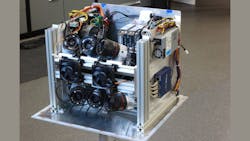Drones or unmanned aerial vehicles (UAVs) are rapidly gaining popularity in commercial and military applications to the point where the U.S. Army is concerned about large numbers of drones. Military troops may be endangered by unexpected large numbers of drones unless they have some warning and some ways to prepare. To guard against large numbers of interconnected swarming drones, the Army recently implemented a unique outdoor testing system at its Aberdeen Proving Ground site in Maryland.
Army researchers worked with PhaseSpace, Inc. and their motion-capture technology for testing in outdoor settings. The motion-capture capability is perhaps better associated with the development of commercial video games. As part of the testing, PhaseSpace developed a system to track motion, using illuminated light-emitting-diode (LED) marker strobes for attachment to the UAV test devices. A total of 96 cameras were used within 16 tracking pods (see figure) around the perimeter of the testing area, with overlapping coverage provided by the camera. The studies were described in a technical report: “Implementation and Evaluation of the World’s Largest Outdoor Optical Motion-Capture System,” which examined such factors as ground/aerial agent interactions and counter-UAV approaches that may prove effective against swarms of remotely piloted or autonomous drones.
“This new capability enables us to expand the scale of our testing—from indoor testing in small rooms or spaces typically smaller than half a basketball court, to now the size of five football fields,” said Dan Everson, a researcher at the U.S. Army Combat Capabilities Development Command’s Army Research Laboratory (ARL). “This will allow us to replicate more realistic UAS operation conditions and conduct experiments that were previously not possible, such as using cameras to navigate terrains, testing RF communication within a swarm, and flying larger drones.”
About the Author
Jack Browne
Technical Contributor
Jack Browne, Technical Contributor, has worked in technical publishing for over 30 years. He managed the content and production of three technical journals while at the American Institute of Physics, including Medical Physics and the Journal of Vacuum Science & Technology. He has been a Publisher and Editor for Penton Media, started the firm’s Wireless Symposium & Exhibition trade show in 1993, and currently serves as Technical Contributor for that company's Microwaves & RF magazine. Browne, who holds a BS in Mathematics from City College of New York and BA degrees in English and Philosophy from Fordham University, is a member of the IEEE.
